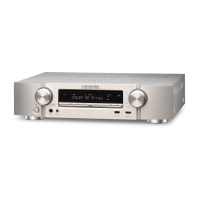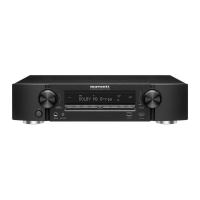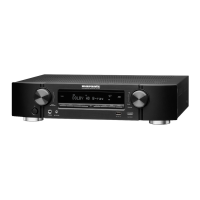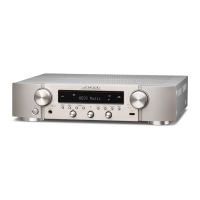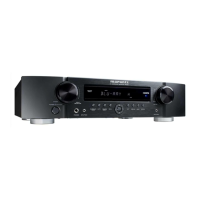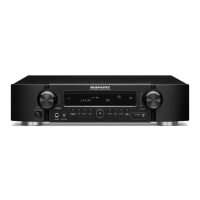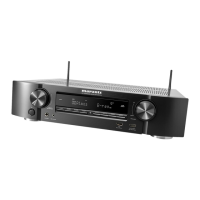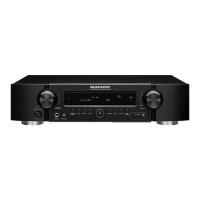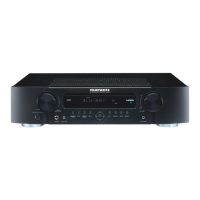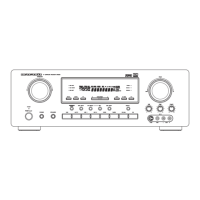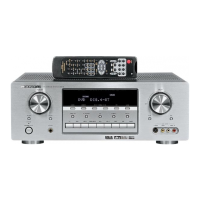Do you have a question about the Marantz NR1602 and is the answer not in the manual?
Detailed cautions and warnings regarding electrical shock, fire, rain, and moisture exposure.
A numbered list of critical instructions for safe operation and maintenance of the unit.
Statement of compliance with EU directives and relevant standards for the product.
Guidelines for recycling packaging materials and proper disposal of the unit and batteries.
Warnings related to operating conditions, heat dispersion, power cord handling, and environment.
Cautions regarding heat dispersal, confined spaces, and placement of equipment.
List of all parts supplied with the Marantz NR1602 AV Surround Receiver.
Overview of core features like power output, streaming, app compatibility, HDMI 1.4a, and GUI.
Information on HDMI inputs/outputs, high-definition audio support, and M-XPort expandability.
Cautions on handling, condensation, mobile phone interference, moving the unit, and cleaning.
Guide to connecting various devices like TV, Blu-ray, CD player, and network sources.
Overview of settings related to speakers, network, and general system configuration.
Steps for selecting input sources, adjusting volume, and basic playback controls.
Guide to selecting appropriate listening modes for movies, music, and games.
Essential information and notes before connecting devices to the unit.
Explanation of how the unit converts and outputs video signals to a monitor.
Illustrations showing menu screens and status displays when input source or volume changes.
Details on HDMI 1.4a features like 3D, ARC, Deep Color, x.v.Color, and HDMI Control.
Explanation of HDCP system for digital video and audio playback via HDMI.
Recommendations for High Speed HDMI cables for Deep Color and ARC functions.
How to link operations between HDMI-connected devices using the CEC function.
Diagrams showing HDMI cable connections and connecting devices with DVI-D connectors.
Configuration options for Input Assign and general HDMI Setup.
Guide to connecting TVs via video, HDMI, and optical audio inputs.
Notes on using the OPTICAL input connector for TV audio.
Guide to connecting Blu-ray players via video, HDMI, and audio cables.
Notes on using HDMI connection for HD Audio playback.
Guide to connecting DVD players via video, HDMI, and audio cables.
Notes on assigning input connectors for DVD players.
Guide to connecting set-top boxes via video, HDMI, and audio cables.
Notes on assigning input connectors for set-top boxes.
Notes on USB memory device compatibility, iPad support, and handling precautions.
List of iPod and iPhone models compatible with the unit.
Instructions for assembling and positioning the AM loop antenna.
Guide to connecting CD players via audio and optical cables.
Notes on assigning input connectors for CD players.
Information on connecting the RX101, diagrams, and operational notes.
Details on necessary items like Modem, Router, and Ethernet cable for network connection.
Important notes regarding ISP contracts, router compatibility, and network setup.
Introduction to Audyssey Auto Setup for optimizing speaker settings.
Introduction to network setup for connecting to a home network.
Instructions for setting up the measurement microphone on a tripod or stand.
Guidelines for setting up the subwoofer for Audyssey Auto Setup.
Setting the remote control unit to AMP operation mode for Audyssey setup.
Connecting the microphone and proceeding to the next step in the setup.
Initiating the main measurement process for speaker configuration and levels.
Handling potential error messages during the Audyssey Auto Setup process.
Performing measurements at multiple listening positions for increased accuracy.
Analyzing measurement results to determine speaker frequency response and distortion.
Checking speaker configuration, distance, level, and crossover settings.
Saving the measurement results after the Audyssey Auto Setup is completed.
Unplugging the microphone and configuring Audyssey Dynamic Volume settings.
Troubleshooting issues related to microphone connection or speaker detection.
Resolving problems caused by excessive ambient noise during measurements.
Troubleshooting when speakers are not detected or identified correctly.
Addressing issues with reversed speaker polarity during setup.
Checking speaker configuration, distance, level, and crossover frequency after setup.
Steps for connecting the unit to a home network via Ethernet.
Methods for selecting the desired input source using menus or buttons.
How to adjust the main volume level using the unit or remote control.
Instructions for temporarily muting the audio output.
Methods for switching input sources using the remote control or main unit.
Adjusting master volume and temporarily muting the sound output.
Setting which front speakers (A, B, or A+B) are to be used.
Steps to prepare for playback, including powering devices and setting inputs.
Instructions for playing discs after connecting the player.
Steps to prepare for CD playback, including powering devices and setting inputs.
Instructions for playing CDs after connecting the player.
Connecting an iPod to the unit's USB port.
Switching the input source to 'NET/USB' to access the iPod.
Selecting songs, playlists, artists, and albums for playback.
Switching between Remote and Direct modes, and controlling playback.
Detailed explanation of remote control buttons used for iPod operation.
Notes on USB device compatibility, album art, slide shows, and network playback.
Simultaneous playback of music and image files from a network.
List of compatible audio and image file formats for USB devices.
Explanation of remote control buttons for operating USB devices.
Function to play music and image files from USB simultaneously.
Instructions for tuning FM and AM radio stations manually or automatically.
Steps for manually presetting favorite radio stations for easy access.
How to access and listen to pre-stored radio stations.
Entering a specific frequency to tune into a radio station.
Automatically tuning to FM stations broadcasting RDS data.
Finding radio stations broadcasting a designated program type (PTY).
Finding radio stations that broadcast traffic announcements (TP stations).
Displaying text messages broadcast by RDS stations.
Switching between FM/AM bands and tuning modes.
Changing the tuning increment for FM and AM radio frequencies.
Information on receiving and managing Internet radio stations.
Playing music files from a computer and displaying album art.
Playing JPEG files as a slideshow and simultaneous network playback.
Information on using Flickr, Last.fm, and Napster services with the unit.
List of compatible audio formats for Internet radio and media servers.
Steps for selecting and playing Internet radio stations.
How to play the last played station or access recently played stations.
Finding stations using alphabetic keywords.
Directly selecting and presetting internet radio stations.
Assigning internet radio stations to preset channel buttons.
Listening to stations registered to preset channel buttons (P1-P3).
Adding stations to favorites and listening to them.
Removing stations from the favorites list.
Steps to play music, image, or playlist files from a computer via network.
Information on presetting and managing computer files in favorites.
Viewing photographs shared by specific Flickr users.
Browsing all content on Flickr by category (Interestingness, Recent, Search).
Explanation of remote control buttons for media server operations.
Steps to log in to your Last.fm account.
Browsing popular stations, recent stations, and searching for content.
Steps to set up and log in to your Napster account.
Navigating Napster menus and searching for tracks.
Registering and listening to tracks saved in your Napster library.
Explanation of remote control buttons for Napster operations.
Steps to prepare for selecting a listening mode, including playing the selected device.
Instructions for selecting modes like SURROUND, AUTO, STEREO, and PURE DIRECT.
Table showing selectable surround modes and adjustable parameters for each.
Descriptions of Dolby and DTS listening modes, including channel configurations.
Description of multi-channel PCM listening modes.
Descriptions of Marantz original modes (MULTI CH STEREO, VIRTUAL) and STEREO mode.
Explanation of DIRECT and PURE DIRECT modes for high-quality audio playback.
Overview of advanced speaker installation and connection procedures.
Details on advanced connection methods like remote control connectors.
Overview of advanced playback features like HDMI control and AirPlay.
Guide to detailed settings, zone management, web control, and memory functions.
Information on installing speakers, including compatibility with Dolby Pro Logic IIz.
Links to procedures for connecting and setting up speakers.
Diagrams for 6.1ch speaker placement with surround back speakers.
Diagrams for 5.1ch speaker placement.
Diagrams for speaker placement when using Front A/B speakers.
Connection example for 7.1 channel playback using front height speakers.
Notes on speaker cable connections, protection circuit, and impedance.
Connection diagram for 6.1 channel playback using a surround back speaker.
Notes on speaker cable connections and impedance for 6.1ch setup.
Connection diagram for 5.1 channel playback.
Notes on speaker cable connections and impedance for 5.1ch setup.
Connection diagram for using a second set of front speakers.
Notes on speaker cable connections and impedance for A/B front speakers.
Connection diagram for a 2.1 channel setup.
Notes on speaker cable connections and impedance for 2.1ch setup.
Diagram showing Bi-Amp connection for front speakers.
Notes on Bi-Amp connections, speaker terminals, and impedance.
Initial steps for speaker setup: remote control, microphone, and amplifier assignment.
Setting amplifier assignment and speaker configuration (size, type).
Selecting channels for surround back speakers and subwoofer measurement.
Details on connecting remote control receiver units for controlling other Marantz products.
Notes on enabling/disabling the unit's remote sensor function.
Explanation of HDMI control functions and the sleep timer.
Adjusting speaker volume and using AirPlay for music streaming.
Overview of playing network audio, media controllers, and web control.
Using memory functions and the panel lock feature.
Detailed explanation of HDMI control, including notes on power consumption and device compatibility.
Instructions for setting and canceling the sleep timer.
How to adjust the volume level for each speaker channel.
Using the fader function to adjust front/rear speaker volumes simultaneously.
Steps for installing iTunes and setting up AirPlay for music streaming.
Streaming to multiple speakers and controlling iTunes via remote.
Streaming music from iPhone, iPod touch, or iPad directly to the unit.
Steps for starting the party mode as the organizer.
How to join an ongoing party mode session as an attendee.
Instructions for exiting the party mode, with options for attendees' power.
Displaying device status and controlling network devices in other rooms.
Steps to exit device control mode, with options for powering off the remote component.
Playing music or image files from a computer acting as a media server.
Using a media controller to select and play content from the network.
Steps for operating the unit via a web browser, including IP address entry.
Example display of the setup menu screen for web control.
Example display of the web configuration screen for customizing settings.
Example display of the Net Audio screen for playing network content.
Function to back up and recall settings for recovery.
How to disable front panel buttons to prevent accidental operation.
Storing settings for input mode, surround mode, and volumes per input source.
Storing settings made before standby mode for automatic restoration.
Using SURR.BACK/AMP ASSIGN terminals for ZONE2 audio output.
Connecting and configuring speakers for ZONE2 playback.
Selecting sources, adjusting volume, and muting sound for ZONE2.
Checking the remaining time before the unit enters sleep mode.
Instructions for canceling the sleep timer function.
Categorized list of all adjustable settings with page references.
Example of navigating the main menu to select setup items.
Example display of the Audyssey Auto Setup screen with illustrations.
Example of the top menu display on the TV screen.
Examples of displays when changing settings or resetting to defaults.
Overview of methods for inputting characters for settings like names and accounts.
Detailed steps for inputting characters using the on-screen keyboard.
Display of the cursor mode screen for character input.
Steps for inputting characters using cursor buttons and the ENTER key.
How to access and navigate the Audio Adjust menu.
List of parameters that can be adjusted within the Audio Adjust menu.
Details on Panorama, Dimension, C.Width, Height Gain, and other surround parameters.
How to reset surround parameters to their default settings.
Adjusting bass and treble levels for tonal quality.
Setting Audyssey MultEQ®, Dynamic EQ®, and Dynamic Volume®.
Adjusting Dynamic EQ for improved sound quality at lower volumes.
Managing large volume variations between content types.
Using graphic equalizer to adjust tone for each speaker.
Enhancing compressed audio and adjusting audio delay.
Displaying current settings, audio input signals, and normalization values.
Showing HDMI signals, monitor info, and tuner/network preset channels.
Automatic adjustment for dialogue normalization when playing Dolby Digital sources.
How to access and navigate the System Setup menu.
List of main categories within System Setup (Speaker, HDMI, Audio, Network, etc.).
Assigning amplifier outputs to speaker configurations (NORMAL, ZONE2, SPKR-C, Front B, F.HEIGHT).
Setting speaker sizes (Large/Small) for Front, Center, Surround, and Subwoofer.
Setting presence and size for front height speakers.
Configuring subwoofer mode (LFE, LFE+Main) and LFE crossover frequency.
Setting speaker distance from the listening position.
Setting speaker volume levels for test tones to match.
Setting the crossover frequency for bass signals to the subwoofer.
Configuring Auto Lip Sync, HDMI audio output, and HDMI control functions.
Setting standby source and linking unit power to external devices.
Making settings for audio playback and customizing equalizer display.
Making settings for wired LAN connections, including DHCP.
Configuring proxy settings for Internet connection.
Steps for inputting proxy server address, domain name, and port number.
Settings for network function, character display, and PC language.
Setting the network friendly name and restoring default settings.
Configuring Party Mode and accessing Zone Management.
Adjusting ZONE2 channel levels, volume limit, and power-on level.
Configuring notifications for firmware updates and managing other system info.
Setting volume display, limit, and deleting unused input sources.
Configuring screensaver, video format, text display, and master volume display.
Setting display durations for NET/USB, iPod, and Tuner screens.
Renaming zones, setting display on/off, and enabling setup lock.
Checking for and executing firmware updates and adding new features.
Selecting the display language for the menu screens.
How to access and navigate the Input Setup menu.
List of input sources available for configuration.
List of settings available within the Input Setup menu.
Using the auto preset function to program radio stations.
Assigning names to preset memories and skipping selected presets.
Examples and operations for assigning HDMI, Digital, and Component inputs.
Changing HDMI and Digital input connectors assigned to input sources.
Setting video source selection and video processing modes.
Assigning component video input connectors to input sources.
Resetting input assignment settings to their default values.
Setting input modes (Auto, HDMI, Digital, Analog) and decode modes (Auto, PCM, DTS).
Renaming input sources and adjusting audio input levels.
Setting repeat modes (All, One, OFF) and random playback (ON/OFF).
Configuring still picture playback and slide show interval.
Enabling or disabling the remote control sensor.
Using the remote control unit to operate connected AV devices.
Operating devices after switching input sources on the unit.
Buttons on the remote control used for operating external devices.
Methods for registering preset codes: 4-digit code entry or code table scanning.
Table showing default preset codes for various device types.
Steps for manually entering a 4-digit preset code.
Remote control operations for Blu-ray, DVD players, and recorders.
Remote control functions for TV power, input, and channel selection.
Remote control functions for satellite set-top box power, input, and channels.
Step-by-step guide for teaching the remote control new codes.
Methods for erasing saved remote control codes.
Specific procedures for deleting codes for buttons, sources, or all memory.
Reference for identifying and understanding the functions of unit parts.
Access to trademark info, video signals, terms, and troubleshooting guide.
Details on product specifications, manual index, and preset code lists.
Identification and page references for all buttons on the front panel.
Explanation of indicators for decoders, input signals, and general information.
Explanation of indicators for front speakers, master volume, sleep timer, and mute.
Explanation of indicators for Audyssey, surround modes, input modes, HDMI, and tuner.
Identification of all connectors on the rear panel with page references.
Important notes regarding touching rear panel connectors and electrostatic discharge.
Identification and page references for all buttons on the remote control unit.
Instructions for inserting the AAA batteries into the remote control.
Information on the effective operating range and potential interference factors.
Lists trademarks used and information on surround sound.
Information on video signal relationships and definitions of technical terms.
Introduction to playing sources in surround modes for immersive audio.
Table showing adjustable surround parameters for each surround mode.
Chart showing which surround modes are compatible with different input signal types.
Notes on constraints for selecting surround modes based on speaker configuration.
Table showing relationships between input/output video signals and menu display.
Notes on menu operation during 3D video or computer resolution playback.
Definitions for A2DP, Bluetooth, Adobe RGB, AirPlay, App Store, Audyssey terms, and Auto Lip Sync.
Definitions for DLNA, Dolby Digital formats, DTS formats, Downmix, and MP3.
Definitions for DTS formats, FLAC, HDCP, HDMI, and iTunes.
Definitions for LFE, MAIN ZONE, MP3, MPEG, and Pairing.
Definitions for vTuner, WAV, Windows Media DRM, and x.v.Color.
Explanation of ZONE2 operation and playback in a separate room.
Troubleshooting for power not turning on, display issues, and blinking indicators.
Troubleshooting for no audio or video output with HDMI connections.
Troubleshooting for no picture appearing on the TV.
Troubleshooting no audio, surround sound issues, and DTS output problems.
Troubleshooting for poor radio reception, noise, or distortion.
Troubleshooting USB device recognition, file playback, and server connection problems.
Troubleshooting playlist compilation, Napster login, and broken playback.
Troubleshooting AirPlay icon display and no sound issues.
Troubleshooting issues with the remote control unit not operating the set.
Instructions for resetting the unit's microprocessor to default values.
Details on power amplifier ratings, output connectors, and frequency response.
Specifications for standard and component video connectors.
Specifications for FM and AM tuner reception, sensitivity, and distortion.
Information on power supply, power consumption, and standby modes.
Alphabetical and numerical index of topics covered in the manual.
List of preset codes for controlling Blu-ray Disc players from various brands.
List of preset codes for controlling DVD players from various brands.
List of preset codes for controlling satellite receivers from various brands.
List of preset codes for controlling televisions from various brands.
Specifications for the unit's physical size (mm) and weight (kg).
Detailed cautions and warnings regarding electrical shock, fire, rain, and moisture exposure.
A numbered list of critical instructions for safe operation and maintenance of the unit.
Statement of compliance with EU directives and relevant standards for the product.
Guidelines for recycling packaging materials and proper disposal of the unit and batteries.
Warnings related to operating conditions, heat dispersion, power cord handling, and environment.
Cautions regarding heat dispersal, confined spaces, and placement of equipment.
List of all parts supplied with the Marantz NR1602 AV Surround Receiver.
Overview of core features like power output, streaming, app compatibility, HDMI 1.4a, and GUI.
Information on HDMI inputs/outputs, high-definition audio support, and M-XPort expandability.
Cautions on handling, condensation, mobile phone interference, moving the unit, and cleaning.
Guide to connecting various devices like TV, Blu-ray, CD player, and network sources.
Overview of settings related to speakers, network, and general system configuration.
Steps for selecting input sources, adjusting volume, and basic playback controls.
Guide to selecting appropriate listening modes for movies, music, and games.
Essential information and notes before connecting devices to the unit.
Explanation of how the unit converts and outputs video signals to a monitor.
Illustrations showing menu screens and status displays when input source or volume changes.
Details on HDMI 1.4a features like 3D, ARC, Deep Color, x.v.Color, and HDMI Control.
Explanation of HDCP system for digital video and audio playback via HDMI.
Recommendations for High Speed HDMI cables for Deep Color and ARC functions.
How to link operations between HDMI-connected devices using the CEC function.
Diagrams showing HDMI cable connections and connecting devices with DVI-D connectors.
Configuration options for Input Assign and general HDMI Setup.
Guide to connecting TVs via video, HDMI, and optical audio inputs.
Notes on using the OPTICAL input connector for TV audio.
Guide to connecting Blu-ray players via video, HDMI, and audio cables.
Notes on using HDMI connection for HD Audio playback.
Guide to connecting DVD players via video, HDMI, and audio cables.
Notes on assigning input connectors for DVD players.
Guide to connecting set-top boxes via video, HDMI, and audio cables.
Notes on assigning input connectors for set-top boxes.
Notes on USB memory device compatibility, iPad support, and handling precautions.
List of iPod and iPhone models compatible with the unit.
Instructions for assembling and positioning the AM loop antenna.
Guide to connecting CD players via audio and optical cables.
Notes on assigning input connectors for CD players.
Information on connecting the RX101, diagrams, and operational notes.
Details on necessary items like Modem, Router, and Ethernet cable for network connection.
Important notes regarding ISP contracts, router compatibility, and network setup.
Introduction to Audyssey Auto Setup for optimizing speaker settings.
Introduction to network setup for connecting to a home network.
Instructions for setting up the measurement microphone on a tripod or stand.
Guidelines for setting up the subwoofer for Audyssey Auto Setup.
Setting the remote control unit to AMP operation mode for Audyssey setup.
Connecting the microphone and proceeding to the next step in the setup.
Initiating the main measurement process for speaker configuration and levels.
Handling potential error messages during the Audyssey Auto Setup process.
Performing measurements at multiple listening positions for increased accuracy.
Analyzing measurement results to determine speaker frequency response and distortion.
Checking speaker configuration, distance, level, and crossover settings.
Saving the measurement results after the Audyssey Auto Setup is completed.
Unplugging the microphone and configuring Audyssey Dynamic Volume settings.
Troubleshooting issues related to microphone connection or speaker detection.
Resolving problems caused by excessive ambient noise during measurements.
Troubleshooting when speakers are not detected or identified correctly.
Addressing issues with reversed speaker polarity during setup.
Checking speaker configuration, distance, level, and crossover frequency after setup.
Steps for connecting the unit to a home network via Ethernet.
Methods for selecting the desired input source using menus or buttons.
How to adjust the main volume level using the unit or remote control.
Instructions for temporarily muting the audio output.
Methods for switching input sources using the remote control or main unit.
Adjusting master volume and temporarily muting the sound output.
Setting which front speakers (A, B, or A+B) are to be used.
Steps to prepare for playback, including powering devices and setting inputs.
Instructions for playing discs after connecting the player.
Steps to prepare for CD playback, including powering devices and setting inputs.
Instructions for playing CDs after connecting the player.
Connecting an iPod to the unit's USB port.
Switching the input source to 'NET/USB' to access the iPod.
Selecting songs, playlists, artists, and albums for playback.
Switching between Remote and Direct modes, and controlling playback.
Detailed explanation of remote control buttons used for iPod operation.
Notes on USB device compatibility, album art, slide shows, and network playback.
Simultaneous playback of music and image files from a network.
List of compatible audio and image file formats for USB devices.
Explanation of remote control buttons for operating USB devices.
Function to play music and image files from USB simultaneously.
Instructions for tuning FM and AM radio stations manually or automatically.
Steps for manually presetting favorite radio stations for easy access.
How to access and listen to pre-stored radio stations.
Entering a specific frequency to tune into a radio station.
Automatically tuning to FM stations broadcasting RDS data.
Finding radio stations broadcasting a designated program type (PTY).
Finding radio stations that broadcast traffic announcements (TP stations).
Displaying text messages broadcast by RDS stations.
Switching between FM/AM bands and tuning modes.
Changing the tuning increment for FM and AM radio frequencies.
Information on receiving and managing Internet radio stations.
Playing music files from a computer and displaying album art.
Playing JPEG files as a slideshow and simultaneous network playback.
Information on using Flickr, Last.fm, and Napster services with the unit.
List of compatible audio formats for Internet radio and media servers.
Steps for selecting and playing Internet radio stations.
How to play the last played station or access recently played stations.
Finding stations using alphabetic keywords.
Directly selecting and presetting internet radio stations.
Assigning internet radio stations to preset channel buttons.
Listening to stations registered to preset channel buttons (P1-P3).
Adding stations to favorites and listening to them.
Removing stations from the favorites list.
Steps to play music, image, or playlist files from a computer via network.
Information on presetting and managing computer files in favorites.
Viewing photographs shared by specific Flickr users.
Browsing all content on Flickr by category (Interestingness, Recent, Search).
Explanation of remote control buttons for media server operations.
Steps to log in to your Last.fm account.
Browsing popular stations, recent stations, and searching for content.
Steps to set up and log in to your Napster account.
Navigating Napster menus and searching for tracks.
Registering and listening to tracks saved in your Napster library.
Explanation of remote control buttons for Napster operations.
Steps to prepare for selecting a listening mode, including playing the selected device.
Instructions for selecting modes like SURROUND, AUTO, STEREO, and PURE DIRECT.
Table showing selectable surround modes and adjustable parameters for each.
Descriptions of Dolby and DTS listening modes, including channel configurations.
Description of multi-channel PCM listening modes.
Descriptions of Marantz original modes (MULTI CH STEREO, VIRTUAL) and STEREO mode.
Explanation of DIRECT and PURE DIRECT modes for high-quality audio playback.
Overview of advanced speaker installation and connection procedures.
Details on advanced connection methods like remote control connectors.
Overview of advanced playback features like HDMI control and AirPlay.
Guide to detailed settings, zone management, web control, and memory functions.
Information on installing speakers, including compatibility with Dolby Pro Logic IIz.
Links to procedures for connecting and setting up speakers.
Diagrams for 6.1ch speaker placement with surround back speakers.
Diagrams for 5.1ch speaker placement.
Diagrams for speaker placement when using Front A/B speakers.
Connection example for 7.1 channel playback using front height speakers.
Notes on speaker cable connections, protection circuit, and impedance.
Connection diagram for 6.1 channel playback using a surround back speaker.
Notes on speaker cable connections and impedance for 6.1ch setup.
Connection diagram for 5.1 channel playback.
Notes on speaker cable connections and impedance for 5.1ch setup.
Connection diagram for using a second set of front speakers.
Notes on speaker cable connections and impedance for A/B front speakers.
Connection diagram for a 2.1 channel setup.
Notes on speaker cable connections and impedance for 2.1ch setup.
Diagram showing Bi-Amp connection for front speakers.
Notes on Bi-Amp connections, speaker terminals, and impedance.
Initial steps for speaker setup: remote control, microphone, and amplifier assignment.
Setting amplifier assignment and speaker configuration (size, type).
Selecting channels for surround back speakers and subwoofer measurement.
Details on connecting remote control receiver units for controlling other Marantz products.
Notes on enabling/disabling the unit's remote sensor function.
Explanation of HDMI control functions and the sleep timer.
Adjusting speaker volume and using AirPlay for music streaming.
Overview of playing network audio, media controllers, and web control.
Using memory functions and the panel lock feature.
Detailed explanation of HDMI control, including notes on power consumption and device compatibility.
Instructions for setting and canceling the sleep timer.
How to adjust the volume level for each speaker channel.
Using the fader function to adjust front/rear speaker volumes simultaneously.
Steps for installing iTunes and setting up AirPlay for music streaming.
Streaming to multiple speakers and controlling iTunes via remote.
Streaming music from iPhone, iPod touch, or iPad directly to the unit.
Steps for starting the party mode as the organizer.
How to join an ongoing party mode session as an attendee.
Instructions for exiting the party mode, with options for attendees' power.
Displaying device status and controlling network devices in other rooms.
Steps to exit device control mode, with options for powering off the remote component.
Playing music or image files from a computer acting as a media server.
Using a media controller to select and play content from the network.
Steps for operating the unit via a web browser, including IP address entry.
Example display of the setup menu screen for web control.
Example display of the web configuration screen for customizing settings.
Example display of the Net Audio screen for playing network content.
Function to back up and recall settings for recovery.
How to disable front panel buttons to prevent accidental operation.
Storing settings for input mode, surround mode, and volumes per input source.
Storing settings made before standby mode for automatic restoration.
Using SURR.BACK/AMP ASSIGN terminals for ZONE2 audio output.
Connecting and configuring speakers for ZONE2 playback.
Selecting sources, adjusting volume, and muting sound for ZONE2.
Checking the remaining time before the unit enters sleep mode.
Instructions for canceling the sleep timer function.
Categorized list of all adjustable settings with page references.
Example of navigating the main menu to select setup items.
Example display of the Audyssey Auto Setup screen with illustrations.
Example of the top menu display on the TV screen.
Examples of displays when changing settings or resetting to defaults.
Overview of methods for inputting characters for settings like names and accounts.
Detailed steps for inputting characters using the on-screen keyboard.
Display of the cursor mode screen for character input.
Steps for inputting characters using cursor buttons and the ENTER key.
How to access and navigate the Audio Adjust menu.
List of parameters that can be adjusted within the Audio Adjust menu.
Details on Panorama, Dimension, C.Width, Height Gain, and other surround parameters.
How to reset surround parameters to their default settings.
Adjusting bass and treble levels for tonal quality.
Setting Audyssey MultEQ®, Dynamic EQ®, and Dynamic Volume®.
Adjusting Dynamic EQ for improved sound quality at lower volumes.
Managing large volume variations between content types.
Using graphic equalizer to adjust tone for each speaker.
Enhancing compressed audio and adjusting audio delay.
Displaying current settings, audio input signals, and normalization values.
Showing HDMI signals, monitor info, and tuner/network preset channels.
Automatic adjustment for dialogue normalization when playing Dolby Digital sources.
How to access and navigate the System Setup menu.
List of main categories within System Setup (Speaker, HDMI, Audio, Network, etc.).
Assigning amplifier outputs to speaker configurations (NORMAL, ZONE2, SPKR-C, Front B, F.HEIGHT).
Setting speaker sizes (Large/Small) for Front, Center, Surround, and Subwoofer.
Setting presence and size for front height speakers.
Configuring subwoofer mode (LFE, LFE+Main) and LFE crossover frequency.
Setting speaker distance from the listening position.
Setting speaker volume levels for test tones to match.
Setting the crossover frequency for bass signals to the subwoofer.
Configuring Auto Lip Sync, HDMI audio output, and HDMI control functions.
Setting standby source and linking unit power to external devices.
Making settings for audio playback and customizing equalizer display.
Making settings for wired LAN connections, including DHCP.
Configuring proxy settings for Internet connection.
Steps for inputting proxy server address, domain name, and port number.
Settings for network function, character display, and PC language.
Setting the network friendly name and restoring default settings.
Configuring Party Mode and accessing Zone Management.
Adjusting ZONE2 channel levels, volume limit, and power-on level.
Configuring notifications for firmware updates and managing other system info.
Setting volume display, limit, and deleting unused input sources.
Configuring screensaver, video format, text display, and master volume display.
Setting display durations for NET/USB, iPod, and Tuner screens.
Renaming zones, setting display on/off, and enabling setup lock.
Checking for and executing firmware updates and adding new features.
Selecting the display language for the menu screens.
How to access and navigate the Input Setup menu.
List of input sources available for configuration.
List of settings available within the Input Setup menu.
Using the auto preset function to program radio stations.
Assigning names to preset memories and skipping selected presets.
Examples and operations for assigning HDMI, Digital, and Component inputs.
Changing HDMI and Digital input connectors assigned to input sources.
Setting video source selection and video processing modes.
Assigning component video input connectors to input sources.
Resetting input assignment settings to their default values.
Setting input modes (Auto, HDMI, Digital, Analog) and decode modes (Auto, PCM, DTS).
Renaming input sources and adjusting audio input levels.
Setting repeat modes (All, One, OFF) and random playback (ON/OFF).
Configuring still picture playback and slide show interval.
Enabling or disabling the remote control sensor.
Using the remote control unit to operate connected AV devices.
Operating devices after switching input sources on the unit.
Buttons on the remote control used for operating external devices.
Methods for registering preset codes: 4-digit code entry or code table scanning.
Table showing default preset codes for various device types.
Steps for manually entering a 4-digit preset code.
Remote control operations for Blu-ray, DVD players, and recorders.
Remote control functions for TV power, input, and channel selection.
Remote control functions for satellite set-top box power, input, and channels.
Step-by-step guide for teaching the remote control new codes.
Methods for erasing saved remote control codes.
Specific procedures for deleting codes for buttons, sources, or all memory.
Reference for identifying and understanding the functions of unit parts.
Access to trademark info, video signals, terms, and troubleshooting guide.
Details on product specifications, manual index, and preset code lists.
Identification and page references for all buttons on the front panel.
Explanation of indicators for decoders, input signals, and general information.
Explanation of indicators for front speakers, master volume, sleep timer, and mute.
Explanation of indicators for Audyssey, surround modes, input modes, HDMI, and tuner.
Identification of all connectors on the rear panel with page references.
Important notes regarding touching rear panel connectors and electrostatic discharge.
Identification and page references for all buttons on the remote control unit.
Instructions for inserting the AAA batteries into the remote control.
Information on the effective operating range and potential interference factors.
Lists trademarks used and information on surround sound.
Information on video signal relationships and definitions of technical terms.
Introduction to playing sources in surround modes for immersive audio.
Table showing adjustable surround parameters for each surround mode.
Chart showing which surround modes are compatible with different input signal types.
Notes on constraints for selecting surround modes based on speaker configuration.
Table showing relationships between input/output video signals and menu display.
Notes on menu operation during 3D video or computer resolution playback.
Definitions for A2DP, Bluetooth, Adobe RGB, AirPlay, App Store, Audyssey terms, and Auto Lip Sync.
Definitions for DLNA, Dolby Digital formats, DTS formats, Downmix, and MP3.
Definitions for DTS formats, FLAC, HDCP, HDMI, and iTunes.
Definitions for LFE, MAIN ZONE, MP3, MPEG, and Pairing.
Definitions for vTuner, WAV, Windows Media DRM, and x.v.Color.
Explanation of ZONE2 operation and playback in a separate room.
Troubleshooting for power not turning on, display issues, and blinking indicators.
Troubleshooting for no audio or video output with HDMI connections.
Troubleshooting for no picture appearing on the TV.
Troubleshooting no audio, surround sound issues, and DTS output problems.
Troubleshooting for poor radio reception, noise, or distortion.
Troubleshooting USB device recognition, file playback, and server connection problems.
Troubleshooting playlist compilation, Napster login, and broken playback.
Troubleshooting AirPlay icon display and no sound issues.
Troubleshooting issues with the remote control unit not operating the set.
Instructions for resetting the unit's microprocessor to default values.
Details on power amplifier ratings, output connectors, and frequency response.
Specifications for standard and component video connectors.
Specifications for FM and AM tuner reception, sensitivity, and distortion.
Information on power supply, power consumption, and standby modes.
Alphabetical and numerical index of topics covered in the manual.
List of preset codes for controlling Blu-ray Disc players from various brands.
List of preset codes for controlling DVD players from various brands.
List of preset codes for controlling satellite receivers from various brands.
List of preset codes for controlling televisions from various brands.
Specifications for the unit's physical size (mm) and weight (kg).
| Frequency range | 10 - 100000 Hz |
|---|---|
| Speaker selector | A+B |
| Input sensitivity | 130 mV |
| Audio output channels | 7.1 channels |
| Signal-to-Noise Ratio (SNR) | 98 dB |
| Power output per channel (20-20KHz@8 Ohm) | 50 W |
| HDMI in | 4 |
| AC (power) in | Yes |
| Composite video in | 3 |
| Digital audio optical in | 1 |
| Multichannel audio input type | Terminals |
| Component video (YPbPr/YCbCr) in | 2 |
| Connectivity technology | Wired |
| Speakers connectivity type | Clamp terminals |
| Audio formats supported | AAC, FLAC, MP3, WAV, WMA |
| Wi-Fi | No |
| AM band range | 522 - 1611 kHz |
| FM band range | 87.5 - 108 MHz |
| Supported radio bands | AM, FM |
| Internet radio services supported | Last.fm, vTuner |
| Display | LCD |
| HDMI version | 1.4 |
| Product color | Black |
| Audio decoders | Dolby Digital EX, Dolby Digital Plus, Dolby TrueHD |
| Volume control | Rotary |
| Apple docking compatibility | iPhone, iPod |
| AC input voltage | 230 V |
| AC input frequency | 50 - 60 Hz |
| Power consumption (standby) | 0.2 W |
| Power consumption (typical) | 220 W |
| Cables included | AC |
| Depth | 367 mm |
|---|---|
| Width | 440 mm |
| Height | 105 mm |
